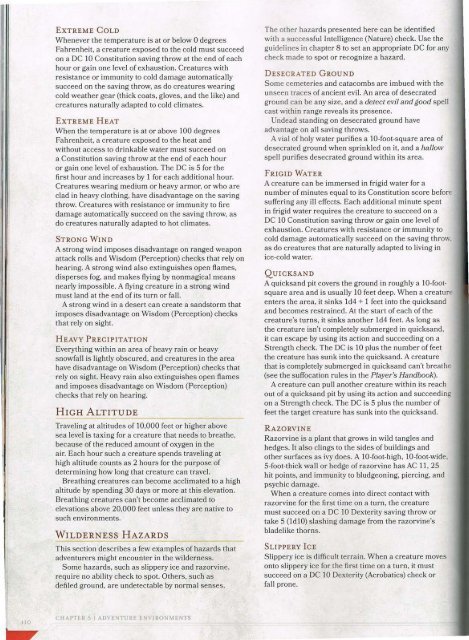Dungeon Master's Guide
Create successful ePaper yourself
Turn your PDF publications into a flip-book with our unique Google optimized e-Paper software.
EXTREME COLD<br />
Whenever the temperature is at or below 0 degrees<br />
Fahrenheit, a creature exposed to the cold must succeed<br />
on a DC 10 Constitution saving throw at the end of each<br />
hour or gain one level of exhaustion. Creatures with<br />
resistance or immunity to cold damage automatically<br />
succeed on the saving throw, as do creatures wearing<br />
cold weather gear (thick coats, gloves, and the like) and<br />
creatures naturally adapted to cold climates.<br />
EXTREME HEAT<br />
When the temperature is at or above 100 degrees<br />
Fahrenheit, a creature exposed to the heat and<br />
without access to drinkable water must succeed on<br />
a Constitution saving throw at the end of each hour<br />
or gain one level of exhaustion. The DC is 5 for the<br />
first hour and increases by 1 for each additional hour.<br />
Creatures wearing medium or heavy armor, or who are<br />
clad in heavy clothing, have disadvantage on the saving<br />
throw. Creatures with resistance or immunity to fire<br />
damage automatically succeed on the saving throw, as<br />
do creatures naturally adapted to hot climates.<br />
STRONG WIND<br />
A strong wind imposes disadvantage on ranged weapon<br />
attack rolls and Wisdom (Perception) checks that rely on<br />
hearing. A strong wind also extinguishes open flames,<br />
disperses fog, and makes flying by nonmagical means<br />
nearly impossible. A flying creature in a strong wind<br />
must land at the end of its turn or fall.<br />
A strong wind in a desert can create a sandstorm that<br />
imposes disadvantage on Wisdom (Perception) checks<br />
that rely on sight.<br />
HEAVY PRECIPITATION<br />
Everything within an area of heavy rain or heavy<br />
snowfall is lightly obscured, and creatures in the area<br />
have disadvantage on Wisdom (Perception) checks that<br />
rely on sight. Heavy rain also extinguishes open flames<br />
and imposes disadvantage on Wisdom (Perception)<br />
checks that rely on hearing.<br />
HIGH ALTITUDE<br />
--------------~------------------<br />
Traveling at altitudes of 10,000 feet or higher above<br />
sea level is taxing for a creature that needs to breathe,<br />
because of the reduced amount of oxygen in the<br />
air. Each hour such a creature spends traveling at<br />
high altitude counts as 2 hours for the purpose of<br />
determining how long that creature can travel.<br />
Breathing creatures can become acclimated to a high<br />
altitude by spending 30 days or more at this elevation.<br />
Breathing creatures can't become acclimated to<br />
elevations above 20,000 feet unless they are native to<br />
such environments.<br />
WILDERNESS HAZARDS<br />
This section describes a few examples of hazards that<br />
adventurers might encounter in the wilderness.<br />
Some hazards, such as slippery ice and razorvine,<br />
require no ability check to spot. Others, such as<br />
defiled ground, are undetectable by normal senses.<br />
The other hazards presented here can be identified<br />
with a successful Intelligence (Nature) check. Use the<br />
guidelines in chapter 8 to set an appropriate DC for any<br />
check made to spot or recognize a hazard.<br />
DESECRATED GROUND<br />
Some cemeteries and catacombs are imbued with the<br />
unseen traces of ancient evil. An area of desecrated<br />
ground can be any size, and a detect evil and good spell<br />
cast within range reveals its presence.<br />
Undead standing on desecrated ground have<br />
advantage on all saving throws.<br />
A vial of holy water purifies a 10-foot-square area of<br />
desecrated ground when sprinkled on it, and a hallow<br />
spell purifies desecrated ground within its area.<br />
FRIGID WATER<br />
A creature can be immersed in frigid water for a<br />
number of minutes equal to its Constitution score before<br />
suffering any ill effects. Each additional minute spent<br />
in frigid water requires the creature to succeed on a<br />
DC 10 Constitution saving throw or gain one level of<br />
exhaustion. Creatures with resistance or immunity to<br />
cold damage automatically succeed on the saving throw.<br />
as do creatures that are naturally adapted to living in<br />
ice-cold water.<br />
QUICKSAND<br />
A quicksand pit covers the ground in roughly a 10-footsquare<br />
area and is usually 10 feet deep. When a creature<br />
enters the area, it sinks ld4 + 1 feet into the quicksand<br />
and becomes restrained. At the start of each of the<br />
creature's turns, it sinks another 1d4 feet. As long as<br />
the creature isn't completely submerged in quicksand,<br />
it can escape by using its action and succeeding on a<br />
Strength check. The DC is 10 plus the number of feet<br />
the creature has sunk into the quicksand. A creature<br />
that is completely submerged in quicksand can't breathe<br />
(see the suffocation rules in the Player's Handbook).<br />
A creature can pull another creature within its reach<br />
out of a quicksand pit by using its action and succeeding<br />
on a Strength check. The DC is 5 plus the number of<br />
feet the target creature has sunk into the quicksand.<br />
RAZORVINE<br />
Razorvine is a plant that grows in wild tangles and<br />
hedges. It also clings to the sides of buildings and<br />
other surfaces as ivy does. A 10-foot-high, 10-foot-wide,<br />
5-foot-thick wall or hedge of razorvine has AC 11, 25<br />
hit points, and immunity to bludgeoning, piercing, and<br />
psychic damage.<br />
When a creature comes into direct contact with<br />
razorvine for the first time on a turn, the creature<br />
must succeed on a DC 10 Dexterity saving throw or<br />
take 5 (1d10) slashing damage from the razorvine's<br />
bladelike thorns.<br />
SLIPPERY IcE<br />
Slippery ice is difficult terrain. When a creature moves<br />
onto slippery ice for the first time on a turn, it must<br />
succeed on a DC 10 Dexterity (Acrobatics) check or<br />
fall prone.<br />
no<br />
CHAPTER 5 I ADVENTURE ENVJRONMENTS




